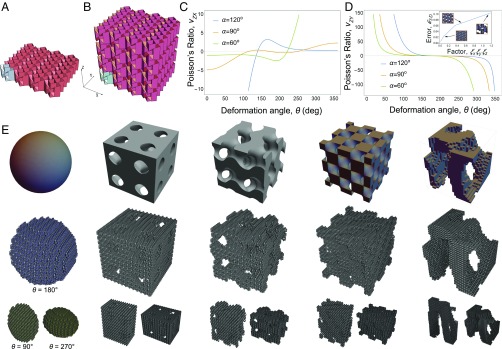Fig. 4.
Assembly of kirigami modules into voxelized 3D mechanical metamaterials. (A) Tessellating voxels in the -plane leads to metamaterials that are (B) stackable along the -axis. These structures have mechanical properties independent of their ability to tessellate 3D space. Plots of the Poisson ratios (C) and (D) as a function of deformation angle show a wide range of allowable behaviors for the same cuboid bulk structure in B, but with variable parameters for and . For the plots shown here, we chose to obtain a wide variety of behavior in . D, Inset shows the error between target 3D structure and voxelized 3D structure as a function of the product of scaling factors , and (Materials and Methods). Larger values of lead to larger voxels with a coarser approximation of the target structure, whereas lower values of have smaller voxels and a more fine approximation. (E) The top row shows five target 3D structures representing a sphere, three triply-periodic minimal surfaces, and a digitized micro-CT scan of a mouse femur bone. The second and third rows are renderings of the different voxelized 3D metamaterials with folding configurations given by , and Increasing corresponds to compression along , whereas decreasing corresponds to tension along . Although all structures have identical compressive properties (, and ), the scaling factor triplets are for the sphere and triply-periodic minimal surfaces, whereas the micro-CT scan has . These large-scale metamaterials highlight the complex topology that can be achieved independent from the prescribed mechanical properties using the design strategy.

